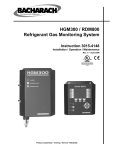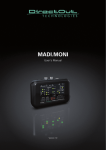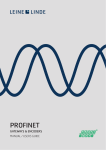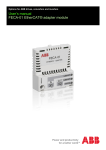Download man_CANopen_eng_under prod.indd
Transcript
CANopen® MANUAL / USERS GUIDE FOR THE 600 SERIES Leine & Linde AB T +46-(0)152-265 00 F +46-(0)152-265 05 [email protected] www.leinelinde.com Publication date: 2012-06-20 CANopen® USER MANUAL www.leinelinde.com Contents List of tables 4 List of figures 4 1 GENERAL INFORMATION 5 1.1 ABSOLUTE ENCODERS 1.2 CANOPEN® TECHNOLOGY 1.3 ABOUT LEINE & LINDE AB 1.3.1 Technical and commercial support 1.3.2 Certification of CANopen® products 1.4 REFERENCES 1.5 ABBREVIATIONS 5 5 5 6 6 6 6 2 ENCODER INSTALLATION 7 2.1 SETTINGS INSIDE THE ENCODER 2.2 NODE ADDRESS 2.3 BUS TERMINATION 2.4 BAUD RATE SWITCH 2.5 CONNECTING THE ENCODER 2.5.1 Power supply 2.5.2 BUS lines 2.5.3 Shielding philosophy 2.6 EDS FILE 2.7 PARAMETERIZATION 2.8 LED INDICATION 2.8.1 Module LED 2.8.2 Status LED 7 7 8 8 9 9 9 10 10 11 11 11 12 3 PROFILE OVERVIEW 13 4 ENCODER FUNCTIONALITY 14 4.1 BASIC ENCODER FUNCTIONALITY 4.2 DEFAULT IDENTIFIERS 4.3 BOOT-UP MESSAGE 4.4 OPERATING PARAMETERS 4.5 SCALING FUNCTION 4.5.1 Overview 4.5.2 Scaling formulas 4.6 PRESET VALUE 4.6.1 Overview 4.6.2 Preset formula 4.7 ZERO-SET 4.8 VELOCITY AND ACCELERATION 4.9 LSS, LAYER SETTING SERVICES 4.10 PDO MAPPING 4.10.1 PDO configuration 4.10.2 PDO configuration example 4.11 HEARTBEAT 4.12 IRT MODE 14 14 15 15 16 16 17 17 17 18 18 18 18 20 20 21 21 22 3 CANopen® USER MANUAL www.leinelinde.com 4.13 ENCODER DIAGNOSTICS 4.13.1 Operating status 4.13.2 Alarms and warnings 5 MANUFACTURER SPECIFIC OBJECTS 5.1 OBJECT 0x5003h, SPEED TYPE 5.2 OBJECT 0x5A03h, SERIAL NUMBER 22 22 23 24 24 24 6 ENCODER CONFIGURATION EXAMPLE 25 7 CERTIFICATE 26 8 REVISION HISTORY 27 List of tables Table 1 Termination switch settings Table 2 Baud rate switch settings Table 3 Pinning M12 power supply connector Table 4 Pinning bus in/out- lines M12 version Table 5 Module LED indication Table 6 Status LED indication Table 7 CANopen® identifier Table 8 Broadcast objects Table 9 Peer-to-Peer objects Table 10 Operating parameters Table 11 Singleturn scaling parameter format Table 12 Multiturn scaling parameter format Table 13 Preset value format Table 14 Objects available for PDO-mapping Table 15 PDO-mapping parameter Table 16 PDO-mapping example Table 17 PDO-mapping example, output data Table 18 PDO-mapping example, save to EEPROM Table 19 Operating parameters (object 0x6000h) Table 20 Alarms (object 0x6506h/0x6505h) and Warnings (object 0x6504h/0x6503h) Table 21 Speed resolution setting Table 22 Accuracy of speed measurement Table 23 SDO request message Table 24 NMT “start remote node” message Table 25 Revision history 8 8 9 9 11 12 14 14 15 15 16 16 17 20 20 21 21 21 22 23 24 24 25 25 27 List of figures Figure 1 PCB-view of a cable gland CANopen® encoder Figure 2 Orientation of M12 power supply connector Figure 3 Orientation of M12 bus connectors Figure 4 Cable assembling principal Figure 5 Basic encoder functionality Leine & Linde AB claims copyright on this documentation. This documentation may not be modified, extended or passed onto to a third party and/or copied without written approval from Leine & Linde AB. Specifications and content in this document are subject to change without prior notice due to our continuous efforts to improve the functionality and performance of our products. 4 7 9 9 10 14 CANopen® USER MANUAL www.leinelinde.com 1 General information 1.1 Absolute Encoders With an absolute encoder each angular position is assigned a coded position value generated by a code disc equipped with several parallel fine graduations tracks which are scanned individually. On singleturn encoders, i.e. an encoder producing absolute positions within one revolution, the absolute position information repeats itself with every revolution. A multiturn encoder can also distinguish between revolutions. The numbers of unique revolutions is determined by the resolution of the multiturn scanning and repeats itself after the total resolution is reached. 1.2 CANopen® technology The CANopen® communication profile is based on the CAN Application Layer (CAL) specification from the CiA® (CAN in Automation). CANopen® is regarded as a robust field bus with highly flexible configuration possibilities. It is used in many various applications all based on different application profiles. CANopen® comprises a concept to configure and communicate real-time data using both synchronous and asynchronous messages. Four types of message (objects) are distinguished: 1. Administrative messages (Layer Management, Network Management and Identifier Distribution Messages) 2. Service Data Messages (SDO) 3. Process Data Messages (PDO) 4. Pre-defined Messages (Synchronization-, Time-stamp-, Emergency Messages) For further information please view the CANopen® specification. 1.3 About Leine & Linde AB For more than 40 years the Swedish based company Leine & Linde has concentrated on one thing – development and manufacturing of advanced encoders that meet the most rigorous demands. That is why a wide selection of incremental and absolute encoders with obvious concentration on robust products and quality down to the last detail can be offered. Leine & Linde encoders provide the utmost in reliability year after year, in working conditions where vibration, dirt, cold and other harsh environments are common. Leine & Linde can meet very specific individual customer demands. The encoders are easily adapted, due to a modular design, to the customer’s exact need with respect to resolution, electrical connections and interfaces, casings, etc. That is due to the fact that tomorrow’s technology already is used today in Leine & Linde ’s product lines. Leine & Linde concentrate on advanced development of intelligent encoders with integrated ASICs, new special features and with adaptations to different fieldbus systems such as CANopen®. This enables us to meet the need for increasingly effective and dependable machines and automation to an even higher degree. 5 CANopen® USER MANUAL www.leinelinde.com 1.3.1 Technical and commercial support Leine & Linde are represented by subsidiaries in many countries around the world. In addition, there are many services agencies and distributors located worldwide ready to reply to commercial enquires or technical support. For more contact information, please visit our web site or contact Leine & Linde in Strängnäs, Sweden. Leine &Linde AB Box 8 SE-645 21 Strängnäs, Sweden Tel: +46-(0)152-265 00 Fax: +46-(0)152-265 05 E-mail: [email protected] Web: www.leinelinde.com 1.3.2 Certification of CANopen® products In order to achieve interoperability between vendors and appropriate device functionality CANopen® products developed and manufactured by Leine & Linde AB has been verified by external bodies. Leine &Linde AB are proud to announce that CANopen® enabled products successfully passed a certification process performed by CiA®, CAN in Automation. A copy of the certificate is attached in this manual. 1.4 References http://www.can-cia.org CAN Application Layer, DS 201 …207 CAL Based Communication Profile, DS 301 Device Profile for Encoders, DS 406 CAN Specification Version 2.0 A CANary CAN controller CiA® CiA® CiA® Robert Bosch GmbH Atmel 1.5 Abbreviations CAN CiA® CAL EDS DCF SDO PDO TPDO COB-ID NMT IRT LSS 6 Controller Area Network CAN in Automation CAN Application Layer Electronic Data Sheet Device Configuration File Service Data Object Process Data Object Transmit PDO Communication Object Identifier Network Management Isochronous Real Time Layer Setting Services CANopen® USER MANUAL www.leinelinde.com 2 Encoder Installation 2.1 Settings inside the encoder The encoder node address, baud rate and bus termination must be configured during commissioning of the device. This is done by removing the back cover and open up the three screws at the rear of the encoder. Screw terminal for bus and power supply connection Node address switches Zero-set button Bus termination on/off Baud rate switch Figure 1 PCB-view of a cable gland CANopen® encoder 2.2 Node address The node address of the device can be set using two decimal rotary switches located inside the back cover. The weighting, x10 and x1 are specified beside the switches. Permissible address range is between 1 and 98 (99 is used for accessing LSS). Address 0 is used for broadcasting, i.e. the master broadcasting to multiple slaves. Note: Each address used in a CANopen® network must be unique and may not be used by other devices. The device address is read and adopted when the encoder power supply is switched on (or NMT command Reset_Communication or Reset_Node). Either of these actions is therefore required in order to adopt changes done to the address settings (except when LSS service is used). 7 CANopen® USER MANUAL www.leinelinde.com 2.3 Bus termination In a CANopen® network, all devices are connected in a bus structure. Up to 126 devices (master and/or slaves) can be connected in one segment. When more devices are needed repeaters should be used to amplify the signals between segments. An active termination need to be placed in the beginning and end of each bus segment in order to ensure error-free operation. In case of cable gland encoder such terminators are integrated inside the back cover and can be activated via the dip switches. The active termination is only activated when the encoder is powered on. If the device is un-powered the CAN_H and CAN_L lines are internally terminated by a 121Ω resistor. Bit 1 Bit 2 Effect ON ON There is a 121 ohm resistor between CAN_H and CAN_L. ON OFF Not a valid setting. OFF ON Not a valid setting. OFF OFF There is no resistor between CAN_H and CAN_L. Table 1 Termination switch settings When encoder with M12 connectors is used the termination must be done using a terminating resistor plug. The terminating resistor plug is available as an accessory from Leine & Linde. The plug is assembled in resemblance to the M12 cables and both male and female contacts are available in order to enable termination in both ends of the bus. 2.4 Baud rate switch The communication baud rate can be set using the rotary switch inside the encoder. The baud rate is set according to table 2 below. If the baud rate switch is set to 9, the baud rate can be set by LSS service. For more information regarding LSS, see chapter 4.9. Baudrate Baudrate switch 10 kbit/s 0 20 kbit/s 1 50 kbit/s 2 125 kbit/s 3 250 kbit/s 4 500 kbit/s 5 800 kbit/s 6 1000 kbit/s 7 400 kbit/s 8 LSS service 9 Table 2 Baud rate switch settings 8 CANopen® USER MANUAL www.leinelinde.com 2.5 Connecting the encoder 2.5.1 Power supply The power supply connection of M12 equipped encoders are constituted by a male A-coded 4 pin M12 connector. Power supply M12 version Power supply Figure 2 Orientation of M12 power supply connector Function Pin +EV (9-36Vdc) 1 Not connected 2 0V 3 Not connected 4 Table 3 Pinning M12 power supply connector Encoders equipped with cable glands are delivered with a dust protection foil from the factory. The protection foil needs to be removed prior to installing the cables. The cable gland encoders should always be equipped with a shielded power supply cable with conductor area between 0,34mm2 to 1.5mm2. Permissible outer cable diameter is ø8mm to ø10mm. Located inside the back cover are two screw terminals containing the required power supply terminals marked (+) and (-). In the case were the encoder is the last node in the bus-structure and only the cable for the Supply and Bus-in is in use, the Bus-out cable gland should be replaced with a M16 filler plug to ensure proper sealing. The M16 filler plug is available as an accessory from Leine & Linde. The (+) terminal shall be used to connect the +EV-line (9-36Vdc). The (-) terminal shall be used to connect the 0V-line. 2.5.2 BUS lines The CANopen® bus line connections of the M12 equipped encoder are constituted by a male A-coded 5 pin M12 connector (bus in), and a female A-coded 5 pin M12 connector (bus out). Bus in/out- lines M12 version Bus out Bus in Figure 3 Orientation of M12 bus connectors Function Pin CAN shield 1 CAN V+ NC CAN GND 3 CAN_H 4 CAN_L 5 Table 4 Pinning bus in/out- lines M12 version 9 CANopen® USER MANUAL www.leinelinde.com The cable gland encoders shall be equipped with twisted pair shielded cable in accordance with EN 50170. The guidelines recommend a conductor area higher than 0,34mm2. Permissible outer cable diameter is ø6mm to ø8mm. Located inside the back cover are six screw terminals containing the required bus line terminals marked H, L and G. Cable glands not used, should be replaced with a M16 filler plug to ensure proper sealing. The M16 filler plug is available as an accessory from Leine & Linde. The (H) terminal shall be connected to CAN_H line. The (L) terminal shall be connected to CAN_L line. The (G) terminal shall be connected to CAN_GND line Note: The two H and L-terminals are internally connected to each other, i.e. it does not matter to which pair the bus lines are connected to. 2.5.3 Shielding philosophy Figure 4 Cable assembling principal To achieve the highest possible noise immunity and resistance against other EMI related disturbances the bus and power supply cables shall always be shielded. The screen should be connected to ground on both ends of the cable. In certain cases compensation current might flow over the screen. Therefore a potential compensation wire is recommended. 2.6 EDS file An EDS-file is available for downloading at our homepage, www.leinelinde.se. Due to Leine & Linde ’s constant drive to support our customer with the latest updates of encoder functionality it is recommended to consult Leine & Linde representative for the latest releases. The EDS file describes: • The communication functionality and objects as defined in the CANopen® communication profile DS-301. • The device specific objects as defined in the Encoder Profile DS-406. • Manufacturer specific objects. The EDS file serves as a template for different configurations of one device type. A DCF-file is generated from the EDS-file describing a specific configuration of the device including object values, selected baud rate and module-Id. CANopen® configuration tools are available to support CANopen® network configuration and device configuration via the CAN bus. The information about the device is obtained from the EDS-file. Note: The EDS Installation procedure depends on your configuration tool, please consult your tool supplier if problems occur. 10 CANopen® USER MANUAL www.leinelinde.com 2.7 Parameterization The parameters are set from the configuration tool when the device is in the Pre-Operational state using the objects obtained from the EDS-file. The parameters can also be changed during runtime (Operational state), please be careful as the position data is directly affected by some parameters and will change directly following such parameter message. Therefore changing the scaling function parameters and the code sequence should only be used at encoder standstill. Note: The parameterization procedure depends on your configuration tool, please consult your tool supplier if problems occur. 2.8 LED indication In order to determine the status of the encoder two LED’s are visible from the rear end of the encoder. The module LED indicates status of the module itself. The status LED shows the module status on the bus. The LED’s can be constantly on, off, blinking and flashing. Blinking means on for 200 mS and off for 200 mS. If the LED’s is flashing it is on for 200 mS and off for 1000 mS (single flash) or on 200 mS, off 200 mS, on 200 mS and off 1000 mS (double flash). 2.8.1 Module LED The module LED is a bicolor LED with functionality as below. LED Indication Off No power. Green OK. Red Position error, the encoder is not able to give a correct position value. 3 x Blinking Green, Off, Zero-set button pushed and position set to zero. After 3 blinks the led will automatically go back to the previous state. Blinking red Faulty switch settings. Table 5 Module LED indication 11 CANopen® USER MANUAL www.leinelinde.com 2.8.2 Status LED The status LED is a bicolor LED with two functions; one green LED (Run status) and one red LED (Error status). RUN STATUS (GREEN) LED Indication Blinking green The encoder is NMT state Pre-operational. Single green flash The encoder is NMT state Stopped. Green The encoder is NMT state Operational. ERROR STATUS (RED) LED Indication Off No error. Single red flash Warning limit reached on Receive error counter or Transmit error counter. Double red flash A guard event or a heartbeat event has occurred. Red The encoder is Bus-off. Flashing red/green The encoder does not have any Node_ID Table 6 Status LED indication When the encoder is on error free communication in operational state both the module and the status LED should shown green. 12 CANopen® USER MANUAL www.leinelinde.com 3 Profile overview The Encoder Profile defines the functionality of encoders connected to CANopen®. The operating functions are divided in two device classes: CLASS 1 The Mandatory class with a basic range of functions that all Encoders must support. The class 1 encoder can optionally support selected class 2 functions, these functions must however be implemented according to the profile. CLASS 2 Where the Encoder must support all class 1 functions and all functions defined in class 2. The full class 2 functionality includes: • Absolute position value transfer using either polled, cyclic or sync mode. • Velocity and acceleration output values • Change of code sequence • Preset value settings • Scaling of the encoder resolution Advanced diagnostics including: • Encoder identification • Operating status • Operating time • Alarms and warnings All programming and diagnostic parameters are accessible through SDO’s. The output position value from the encoder is presented in binary format. 13 CANopen® USER MANUAL www.leinelinde.com 4 Encoder functionality 4.1 Basic encoder functionality The figure below gives an overview of the basic encoder functions and how the functionality is conducted within the encoder. Physical position Code sequence Singleturn resolution Number of distinguishable revolutions Basic funtion Absolute position Scaling function Measuring units per revolution Total measuring range in measuring units Scaling function control/status Preset function Preset value Offset value Output position value Figure 5 Basic encoder functionality 4.2 Default identifiers In order to reduce configuration effort a default identifier allocation scheme is defined for CANopen® devices. This ID-allocation scheme consists of a functional part, which determines the object priority and a moduleID-part, which is equal to the node number (1 to 127). Broadcasting of non-confirmed services (NMT and SYNC) is indicated by a module-ID of zero. In CANopen® the 11 bit identifier is built as follows: Bit-Nr 10 9 8 7 Function Code 6 5 4 3 2 1 0 Node Number Table 7 CANopen® identifier The following broadcast objects with default identifiers are available in the encoder: Object Function Code (binary) Resulting Identifier (COB-ID) Priority group NMT 0000 0 0 SYNC 0001 128dec 0 Table 8 Broadcast objects 14 CANopen® USER MANUAL www.leinelinde.com The following Peer-to-Peer objects with default identifiers are available in the encoder: Object Function Code (binary) Resulting Identifier (COB-ID) Priority group EMERGENCY 0001 80h + node id 0, 1 PDO1 (tx) 0011 180h + node id 1, 2 PDO2 (tx) 0101 280h + node id 2, 3 SDO (tx) 1011 580h + node id 6 SDO (rx) 1100 600h + node id 6, 7 Node guard 1110 700h + node id - Table 9 Peer-to-Peer objects 4.3 Boot-up message The encoder sends a Boot-up message after power-on and initialization. This message uses the default Node guard identifier (ID=700h+ node id) and has no data bytes. With this message the user can retrieve the sending node directly from the used identifier (COB-ID) as it is a function of the node number, see chapter 4.2. 4.4 Operating parameters Object 0x6000h, operating parameters, controls the functions for Code sequence and Scaling and read position at Sync. Bit Function Bit = 0 Bit = 1 Class 1 Class 2 0 Code Sequence CW CCW M* M* 1 N.A. 2 Scaling function control Disabled Enabled O M 3 N.A. 4 -11 Reserved for further use 12 - 14 Manufacturer specific parameter N.A. N.A. O O 15 Read position at sync Disabled Enabled - - * not for linear encoders ** not for rotary encoders Table 10 Operating parameters The code sequence defines whether increasing or decreasing position values are output when the encoder shaft rotates clockwise or counterclockwise as seen on the shaft. The scaling function control is used for enabling/disabling the scaling parameters measuring units per revolution (object 0x6001h) and total measuring range in measuring units (object 0x6002h), see chapter 4.5. If the scaling function bit is set, the scaling parameters will affect the output position value. If the scaling function bit is set to zero, the scaling function is disabled. Note: The position value will be affected when the code sequence is changed during operation. It might be necessary to perform a preset after the code sequence has been changed. 15 CANopen® USER MANUAL www.leinelinde.com 4.5 Scaling function 4.5.1 Overview With the scaling function the encoder internal numerical value is converted in software to change the physical resolution of the Encoder. The parameters ”Measuring units per revolution” (object 0x6001h) and ”Total measuring range in measuring units” (object 0x6002h) are the scaling parameters set to operation with the scaling function control bit in object 0x6000h. Note: Total measuring range in measuring units = Measuring units per revolution x Number of distinguishable revolutions. When scaling a multiturn encoder the parameter “Measuring units per revolution” must be sent before the parameter “Total measuring range in measuring units”. The data type for both scaling parameters is unsigned 32 with a value range from 1 to 232 limited by the encoder resolution. For a 25 bit multiturn encoder with a singleturn resolution of 13 bits resolution the permissible value for the ”Measuring units per revolution” is between 1 and 213 (8192). The permissible value for the ”Total measuring range in measuring units” is between 1 and 225 (33 554 432). To achive the highest permissible value of 225 (33 554 432) for the “Total measuring range in meausuring units” the “Measuring units per revolution” must be set to 213 (8192). The scaling parameters are securely stored in case of voltage breakdown and reloaded at each start-up. Byte 3 2 1 0 Bit 31 - 24 23 - 16 15 - 8 7 - 0 Data 231 - 224 223 - 216 215 - 28 27 - 20 Object 0x6001h – Measuring units per revolution Table 11 Singleturn scaling parameter format Byte 3 2 1 0 Bit 31 - 24 23 - 16 15 - 8 7 - 0 Data 231 - 224 223 - 216 215 - 28 27 - 20 Object 0x6002h – Total measuring range in measuring units Table 12 Multiturn scaling parameter format The measuring range is set by the object ”Total measuring range in measuring units”. The encoder has two different operating modes depending on the specified measuring range. If the scaling is binary the encoder enter operation mode A, Cyclic operation and if the scaling value is non-binary the encoder enters operation mode B, Non cyclic operation. A. CYCLIC OPERATION (Binary scaling) Used when operating with 2X number of turns (2, 4, 8, 16, 32, 64, 128, 256, 512, 1024, 2048 and 4096 number of turns). If the desired measuring range is equal to the specified singleturn resolution * 2X (where x <= 12) the encoder operates in endless cyclic operation (0 - max - 0 - max ...). For example: If the position value increases above the maximum value (measuring range-1) by rotating the encoder beyond the maximum value the encoder continues from 0. Example of a cyclic scaling: Measuring units per revolution = 1000 Measuring range = 32000 (25 = 32 number of turns) 16 CANopen® USER MANUAL www.leinelinde.com B. NON CYCLIC OPERATION If the measuring range is used to limit the encoder value range to a value not equal to the specified singleturn resolution * 2x the output position value is limited within the operating range. If the position value increases or decreases outside the measuring range by rotating the encoder beyond the maximum value (measuring range-1) or below 0 the encoder outputs the total measuring range value. 4.5.2 Scaling formulas The scaling function used in the CANopen® encoder is limited to a singleturn resolution within one step. After downloading new scaling parameters the preset function should be used to set the encoder starting point. Note: Changing the scaling function parameters should only be used at encoder standstill. In the following formula a 25 bit multiturn encoder with a singleturn resolution of 13 bits is used as an example. A= (singleturn_position x measuring_units_per_revolution) 8192 output_position = (revolution_number x measuring_units_per_revolution) + A Where: singleturn_position = the Absolute singleturn position value revolution_number = the Absolute multiturn number 4.6 Preset value 4.6.1 Overview The preset function (object 0x6003h) supports adaptation of the encoder zero point to the mechanical zero point of the system. The preset function sets the actual position of the encoder to the preset value. The preset function is used after the scaling which means that the preset value is given in the current measuring units. A preset is handled by the encoder in the following way: The encoder reads the current position value and calculates an offset value from the preset value and the read position value. The position value is shifted with the calculated offset value. The offset value can be read with object 0x6509h and is securely stored in case of voltage breakdown and reloaded at each start-up. Note: The preset function should only be used at encoder standstill. Byte 3 2 1 0 Bit 31 - 24 23 - 16 15 - 8 7 - 0 Data 231 - 224 223 - 216 215 - 28 27 - 20 Object 0x6003h – Preset Value Table 13 Preset value format 17 CANopen® USER MANUAL www.leinelinde.com 4.6.2 Preset formula An offset_value is calculated when the encoder receives the preset_value, see setup calculation below. The offset_value is then used during runtime to shift the current position to get the required output position, see runtime calculation below. Note: In the formulas below the current_position is the Absolute position of the encoder disk after the scaling function. The calculations are made with signed values. Setup calculation: offset_value=preset_value_current_value Note: A previously set offset_value is not included in the current position. Runtime calculation: output_position=current_position+offset_value 4.7 Zero-set Zero setting of the encoder can be done two folded. Using the preset (object 0x6003h) and set the preset value to zero (00 00 00 00h) makes a zero-set of the encoder. Also, if the zero set button is pushed for at least 1 second the position off the encoder will be set to zero (00 00 00 00h). The module LED will signal: green, off, green, off, green, off to confirm that the position value is set to zero. 4.8 Velocity and Acceleration The encoder supports output of both speed (object 0x6030h) and acceleration (object 0x6040h). In order to maintain accuracy independently of the rotation speed of the encoder various measuring unit can be set. The speed object is limited to a signed 16-bit value and an optimization of assumed rotation speed of the shaft with respect to chosen resolution is required in order to avoid data overflow. Object 0x5003h, speed type, is a manufacturer specific object that sets the update time and resolution (Steps/ second or RPM) of the speed (object 0x6030h) and acceleration (object 0x6040h) value. The speed type object is described in chapter 5.1. 4.9 LSS, Layer Setting Services The encoder supports LSS functionality, which is a service to remotely set Node_ID and communication baud rate. The LSS function is not available when the encoder is in the NMT mode “Operational”. To change the Node_ID by LSS, both address switches X10 and X1 must be set to 9. At first start up with the address switches set to 99 the encoder will have a invalid Node_Id. The encoder will therefore not send a boot up message and will only communicate with LSS messages, all other messages (like PDOs and SDOs) will be ignored until a valid Node_ID has been set. If the address switches are set to anything else than 99 at start up, the Node_Id will be set according to the position of the switches. A reset of the LSS-setting will also be made, which means that once the encoder is restarted with the address switches set to 99, the encoder will have an invalid Node_Id, as in the first start up. If the baud rate switch is set to 9, the encoder also enters LSS and the baud rate can be set by LSS. When the encoder starts with the baud rate switch set to 9 the encoder uses the stored baud rate. Before any baud rate has been stored the encoder will use 125 Kbit. If the encoder starts up with the baud rate switch set to anything else than 9, the baud rate will be according to table 2 in chapter 2.4 Baud rate switch. A reset of the LSS-setting will also be made, which means that once the encoder is restarted with the baud rate switch set to 9, the encoder will use 125 Kbit until any other value has been stored. 18 CANopen® USER MANUAL www.leinelinde.com If both baud rate and Node_Id shall be set by LSS, it is recommended to follow the sequence below: 1) Start with enable LSS in all node on the network for both setting Node_Id and Baud rate. This is done on the Leine & Linde encoders by setting all three switches (Baud rate, Address X10 and Address X1) to 9. 2) Switch on power supply. 3) Set all Nodes to “LSS Configuration”. 4) Set the new baud rate with “Configure bit timing parameters”. 5) Store the new value with “Store configuration”. 6) Activate the new baud rate with “Activate bit timing parameters”, chose a delay that is long enough so you have time to change the LSS masters baud rate before the nodes starts to communicate with the new baud rate. 7) Set all Nodes to “LSS Waiting mode” with “Switch state global”. 8) Set one node at a time to “LSS Configuration”. a) First use “LSS switch mode selective Vendor ID” with the nodes vendor ID (obj 0x1018h, sub-index 1). Leine & Linde ´s Vendor ID is “0x00000194h” b) Then use “LSS switch mode selective Product code” with the nodes product code (obj 0x1018h, sub-index 2). Leine & Linde product code for the 600 series is “60010” (258h). c) Then use “LSS switch mode selective Revision number” with the nodes revision number (0x1018h, sub-index 3). The revision number is written on the encoder label. For example 11.0 is written on the encoder label. 11.0 => 0x000B0000h where 000B is the major and 0000 is the minor value. d) Then use “LSS switch mode selective Serial number” with the nodes serial number (0x1018h, sub-index 4). The serial number of the encoder is written on the encoder label as a numerical value in decimal form. Now one (and only one CAN node) is in “LSS Configuration mode”. 9) Set the Node_Id with “Configure Node-ID”. 10) Store the Node_ id with “Store configuration”. 11) Set the node to “LSS Waiting”. The node will now exit LSS and start up with the new Node_id and it will send a “Boot-up” message. 12) Repeat step 8 to 11 for all nodes. 19 CANopen® USER MANUAL www.leinelinde.com 4.10 PDO mapping Dynamic PDO mapping enable changes of the objects sent in a PDO. The Leine &Linde 600 series encoder can map three different objects in to the PDO’s. These are: Name Object Sub index Length Position 0x6004h Speed 0x6030h 1 2 byte Acceleration 0x6040h 1 2 byte 4 byte Table 14 Objects available for PDO-mapping The encoder has two transmit PDO, named PDO1 (sent cyclically by Cyclic_timer) and PDO2 (sent when a SYNC message is received). Both PDO’s are as default mapped to send only position data. Both PDO’s can independently be change to send any combination and order of the object above. The structure of the entries of object “Transmit PDO mapping parameter” sub index 1 – 3 is as follows. Byte MSB Byte MSB - 1 Object Byte LSB + 1 Byte LSB Sub index Object length (Nr of bits) Table 15 PDO-mapping parameter 4.10.1 PDO configuration To change the PDO mapping the encoder must be in NMT mode PRE-OPERATIONAL. The PDO must be set to “not valid”. This is done by clearing bit 31 (MSB) in sub index 1 “COB-ID used by PDO” in object “Transmit PDO communication parameters”. The PDO must be deactivated, set “Transmit PDO mapping parameter” sub index 0 to 0. To reconfigure the PDO mapping send data of which object, sub index and length of the first object to “Transmit PDO mapping parameter” sub index 1. Then do the same for the optionally second and third object to “Transmit PDO mapping parameter” sub index 2 and 3. The “Transmit PDO mapping parameter” sub index 0 must be set to the number of objects mapped to the PDO (1-3). The reconfigured PDO mapping must be set to “valid” by setting bit 31 (MSB) in sub index 1 “COB-ID used by PDO” in object “Transmit PDO communication parameters”. After setting the encoder in NMT mode OPERATIONAL the reconfigured PDO mapping is enabled. The PDO mapping can be securely stored to EEPROM by using the object 0x1010h “Store parameter Field” (sub index 1 “All parameters” or sub index 2 “communication parameters”). 20 CANopen® USER MANUAL www.leinelinde.com 4.10.2 PDO configuration example The following chapter shows how to map PDO1 with position and speed (the encoder has address 0x0Fh, all data in hexadecimal format): Step ID Data 1 0 80 0F Set the encoder in NMT mode PRE-OPERATIONAL. 2 60F 23 00 18 01 8F 01 00 80 Set PDO1 to not valid, and COB-ID to 0x18Fh 3 60F 2F 00 1A 00 00 00 00 00 Set “Transmit PDO mapping parameter” sub index 0 to 0 (mapping deactivated). 4 60F 23 00 1A 01 20 00 04 60 Map position (object 0x6004h) to the first position in the PDO. 5 60F 23 00 1A 02 10 01 30 60 Map Speed (object 0x6030h) to the second position in the PDO. 6 60F 2F 00 1A 00 02 00 00 00 Set “Transmit PDO mapping parameter” sub index 0 to 2 (The number of object mapped to the PDO). 7 60F 23 00 18 01 8F 01 00 00 Set PDO1 to valid, and COB-ID to 0x18Fh 8 0 01 0F Set the encoder in NMT mode OPERATIONAL. Table 16 PDO-mapping example The mapping of the PDO1 is now finished. The PDO1 message can for example look like: ID Data 18F 4E C9 B2 00 53 01 Table 17 PDO-mapping example, output data Where “4E C9 B2 00” is position data and “53 01” is the speed value. To save the PDO mapping to EEPROM send: ID Data 60F 23 10 10 02 73 61 76 65 Save all communication parameters by sending the ASCII code for “SAVE” to object 0x1010h, sub index 2. Table 18 PDO-mapping example, save to EEPROM 4.11 Heartbeat The Leine & Linde CANopen® encoder can act as a heartbeat producer. The time between two heartbeats is configured in object “Producer heartbeat time” (0x1017h) and is in the unit milliseconds (1 - 65535). If the “Producer heartbeat time” (0x1017h) is zero (0) the heartbeat is deactivated. The object “Producer heartbeat time” (0x1017h) is securely stored in the EEPROM and reloaded at start up. 21 CANopen® USER MANUAL www.leinelinde.com 4.12 IRT mode In order to enhance the real-time characteristics the encoder can operate in IRT, Isochronous Real Time mode. In normal operating mode the position value is sampled cyclically every 0.5 mS. If the “Read position at sync” is disabled the PDO2 (send data at sync) uses the last sampled position of the encoder. This adds a non-real time characteristics to the output position value. In IRT mode, “Read position at sync” is set, the position value is only sampled when the sync message is received. When the “Read position at sync” bit is set in the operating parameter (object 0x6000h), the following changes are made: • Speed (object 0x6030h) and the acceleration (object 0x6040h) is disabled because cyclic position sampling is mandatory for calculating these values. • PDO1 (send data cyclic) is disabled, object 0x1800h sub index 1 bit 31 is set and stored to EEPROM. • The object “PDO1 transmit” (object 0x1800h) is read only when the “Read position at sync” bit is set. • The PDO2 (send data at sync) will be set to only send position data and the new PDO2 mapping will be stored in EEPROM. • The object “PDO2 tx mapping” (0x1A01h) will be read only if the “Read position at sync” bit is set. Note: If speed and acceleration values is requested during operation in IRT mode it is recommended to calculate these values in the master application and use the master clock (sync message) as reference. Bit Parameter 0 Code sequence 1 N.A. 2 Scaling function control 3-14 N.A. 15 Read position at sync Table 19 Operating parameters (object 0x6000h) 4.13 Encoder diagnostics The encoder diagnostics can be read from objects 0x65xxh. The operating status, alarm and warning diagnostics are described in the following chapters. For complete overview of the diagnostics supported please view the EDS file. 4.13.1 Operating status In object 0x6500h the operating status can be read. The function for each bit is in reassembles to the operating parameters, see chapter 4.4. Bit 2, scaling function control, in operating status is set depending on the setting in operating parameters in addition the actual scaling values used in the encoder can be read out as diagnostics, object 0x6501h (singleturn resolution) and object 0x6502h (multiturn resolution). 22 CANopen® USER MANUAL www.leinelinde.com 4.13.2 Alarms and warnings If an internal alarm is detected by the encoder it automatically enters pre-operational state. A COB-ID EMCY (object 0x1014h) message is sent by the encoder transferring what type of alarm has occurred. To re-enter the operational state a NMT command has to be sent. The encoder supports the following alarms. Bit Supported_alarms/Alarms Bit 0 Position error 0 1-11 12 E2prom error 13-15 Table 20 Alarms (object 0x6506h/0x6505h) Supported_warnings/Warnings 1 Light control 2 Watchdog 3-15 Warnings (object 0x6504h/0x6503h) 23 CANopen® USER MANUAL www.leinelinde.com 5 Manufacturer specific objects 5.1 Object 0x5003h, Speed type Object 0x5003h sets the update time and resolution (Steps/second or RPM) of the velocity information. This object affects both the speed (object 0x6030h) and the acceleration (object 0x6040h). Speed type Setting 0 200 mS update time, Steps/S. 1 10 mS update time, Steps/10 mS. 2 100 mS update time, Steps/100 mS. 3 200 mS update time, RPM. Table 21 Speed resolution setting The speed object is limited to a signed 16-bit value. In order to avoid data overflow and optimize the accuracy it is recommended to calculate the optimal speed type setting. Also adopt scaling to the encoder limits the amount of data avoiding overflow as the speed value calculation is based on the scaled singleturn value. For example if the rotation of the shaft is faster than 1000 rpm and the speed type are 0, steps/S, a data overflow will occur. In this case a higher resolution is required, i.e. steps/100ms. The accuracy of the speed measurement is dependent on the resolution chosen. The figure in this table should be considered as a guideline. Speed type Shaft rotation 0 >100 RPM 1 >1000 RPM 2 >1000 RPM 3 >100 RPM Table 22 Accuracy of speed measurement The table shows at from which shaft rotation speed the accuracy of the measured value deviates less than 1%. General, independent of speed type chosen, the accuracy improves the higher the shaft rotation is. 5.2 Object 0x5A03h, Serial number 2 Object 0x5A03h is a manufacturer specific object were the serial number of the including base encoder can be read. This object is mainly useful when a gateway solution is used but it is implemented for the integrated encoders as well to maintain a general approach for the supported objects. 24 CANopen® USER MANUAL www.leinelinde.com 6 Encoder configuration example This example shows a simple setup of the encoder for cyclic transmission of the position value. 1) Set the physical address (Node Number) of the encoder using the address switches, see section s.2 for further information. 2) Verify that the baud rate of your CANopen® network and the baud rate of the encoder is the same. See section 2.3 for further information regarding the baud rate setting of the encoder. 3) Power up the encoder. 4) The encoder will send a Boot-up message on the default Node guard identifier (ID = 700h + encoder address), the message has no data bytes. 5) The next step is to configure the encoder through the SDO message. To set a cyclic transmission of the position value with 10ms repetition rate, an SDO request message (ID = 600h + encoder address) sent to the cyclic timer (object 0x6200h) with the data below, is required. The encoder will confirm with the SDO response message (ID = 508h + encoder address). Byte 0 Byte 1 Byte 2 Byte 3 Byte 4 Byte 5 Byte 6 Byte 7 0x22 0x00 0x62 0x00 0x0A 0x00 0x00 0x00 Command Object Subindex 4 byte Data Table 23 SDO request message 6) To get the encoder in operation we need to send an NMT “start remote node” message, ID = 0, two data bytes with the following contents: Byte 0 Byte 1 0x01 The encoder address (Node Number) Table 24 NMT “start remote node” message 7) The encoder has now entered the operational state and the position message (ID = 180h + encoder address) is transferred with a 10ms repetition rate. If an error occur the encoder will send an emergency message (ID = 80h + encoder address). 25 CANopen® USER MANUAL 7 Certificate 26 www.leinelinde.com CANopen® USER MANUAL www.leinelinde.com 8 Revision history Revision Date Changes Rev. 1.0 2012-06-20 First release Table 25 Revision history 27 +46-(0)152-265 00 www.leinelinde.com Part no. 634815-01, ver. 1.0 The best encoders are those you never have to think about. Those that simply do their job – year after year. Leine & Linde develops and manufactures customised encoder solutions for demanding environments, advanced measuring systems for accurate feedback of speed and position.










































